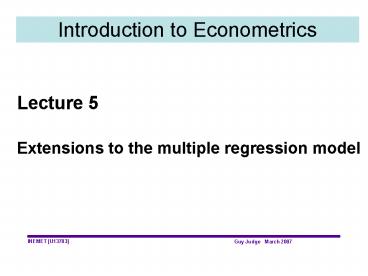Introduction to Econometrics - PowerPoint PPT Presentation
1 / 20
Title:
Introduction to Econometrics
Description:
... example suppose we are investigating the relationship between the wage (Y) and ... Dummy variables and time series data. With time series data we can have ... – PowerPoint PPT presentation
Number of Views:144
Avg rating:3.0/5.0
Title: Introduction to Econometrics
1
Introduction to Econometrics
- Lecture 5
- Extensions to the multiple regression model
2
Lecture plan
- logarithmic transformations - log-linear
(constant elasticity) models - dummy variables for qualitative factors
- simple dynamic models with lagged variables -
the partial adjustment mechanism - an application to illustrate the above - A study
of cigarette consumption in Greece by Vasilios
Stavrinos (Applied Economics, 1987 pp 323-329)
3
Log-linear regression models (1)
- In many cases relationships between economic
variables may be non-linear. However we can
distinguish between functional forms that are
intrinsically non-linear (and will need to be
estimated by some kind of iterative non-linear
least squares method) and those that can be
transformed into an equation to which we can
apply ordinary least squares techniques.
4
Log-linear regression models (2)
- Of those non-linear equations that can be
transformed, the best known is the multiplicative
power function form (sometimes called the
Cobb-Douglas functional form), which is
transformed into a linear format by taking
logarithms.
5
Log-linear regression models (3)
- Production functions
- For example, suppose we have cross-section data
on firms in a particular industry with
observations both on the output (Q) of each firm
and on the inputs of labour (L) and capital (K). - Consider the following functional form
6
Log-linear regression models (4)
7
Log-linear regression models (5)
8
Log-linear regression models (6)
The parameters ? and ? can be estimated directly
from a regression of the variable lnQ on lnL and
lnK
9
Log-linear regression models (7)
10
Log-linear regression models (8)
11
Dummy variables (1)
Dummy variables (sometimes called dichotomous
variables) are variables that are created to
allow for qualitative effects in a regression
model. A dummy variable will take the value 1
or 0 according to whether or not the condition is
present or absent for a particular observation.
For example suppose we are investigating the
relationship between the wage (Y) and the number
of years of experience (X) of workers in a
particular industry. Our initial model is Y a
b X u However we are concerned that the
wages of female workers may be below that of male
workers with similar experience. To test for this
we can introduce a dummy variable to distinguish
between the observations for male and female
workers in the regression.
12
Dummy variables (2)
Define D 1 for male workers and 0 for female
workers. The overall equation becomes Y a
b X cD u where c will measure the
differential between male and female workers,
having taken account of differences in
experience. We can run a normal multiple
regression with X and D as explanatory variables.
Assuming that c is positive it means that the
regression line for male workers lies above that
for female workers - c measures the extent of the
upward shift. We can use its t value to test
whether these differences are statistically
significant.
13
Dummy variables (3)
Ramu Ramanathan (1998) includes a data set
compiled by Susan Wong relating to 49
professionals in an industry (23 are for females
and 26 for males). The results show a large and
significant difference in wages (which range
between 981 and 3833 with a mean of 1820).
14
Yi b1 b2 Xi b3 Di ui
Dummy variables (4) Testing for differences in
intercept.
Yi (b1 b3) b2 Xi ut
For men Di 1.
Y
Men
wage rate
Women
For women Di 0.
Yi b1 b2 Xi ui
b1 b3
b1
0
X
years of experience
15
Yi b1 b2 Xi b3 Di b4 Di Xi ui
Interactive dummies Testing for differences in
intercept and slope
Y
Yi (b1 b3) (b2 b4) Xi ui
Men
wage rate
b2 b4
Women
Yi b1 b2 Xi ui
b2
b1
b1 b3
X
0
years of experience
16
Dummy variables and time series data
- With time series data we can have
- impulse dummies just affecting a particular
period - step dummies affect remains on for a number of
periods - We might also have seasonal dummies
- e.g. lnQt b0 b1 lnYt b2lnPt d1D1t
d2D2t d3 D3t ut - D1 1 for quarter 1 observations, 0 otherwise
- D2 1 for quarter 2 observations, 0 otherwise
- D3 1 for quarter 3 observations, 0 otherwise
- Beware of the dummy variable trap
17
Partial adjustment mechanisms (1)
18
Partial adjustment mechanisms (2)
19
Illustration cigarette consumption in Greece
(see Stavrinos, Applied Economics, 1987 19,
pp323-329)
20
Stavrinos results































